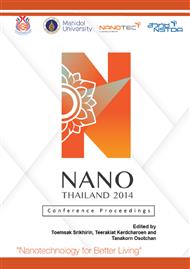[1]
F. Hatami, N.N. Ledentsov, M. Grundmann, J. Bohrer, F. Heinrichsdorff, M. Beer, D. Bimberg, S.S. Ruvimov, P. Werner, U. Gosele, J. Heydenreich, U. Richter, S.V. Ivanov, B. Ya. Meltser, P.S. Kop'ev, Zh.I. Alferov, Radiative recombination in type-II GaSb/GaAs QDs, Appl. Phys. Lett. 67 (1995).
DOI: 10.1063/1.115193
Google Scholar
[2]
P.J. Carrington, M.C. Wagener, J.R. Botha, A.M. Sanchez, A. Krier, Enhanced infrared photo-response from GaSb/GaAs quantum ring solar cells, Appl. Phys. Lett. 101 (2012) 231101(1-5).
DOI: 10.1063/1.4768942
Google Scholar
[3]
W. -H. Lin, C. -C. Tseng, S. -Y. Wu, M. -H. Wu, S. -Y. Lin, M. -C. Wu, The influence of background As on GaSb/GaAs quantum dots and its application in infrared photodetectors, Phys. Status Solidi C 9 (2012) 314-317.
DOI: 10.1002/pssc.201100246
Google Scholar
[4]
T. Kawazu, T. Mano, T. Noda, Y. Akiyama, H. Sakaki, Growth of GaSb dots on GaAs(100) by droplet epitaxy, Phys. Status Solidi B 246 (2009) 733-735.
DOI: 10.1002/pssb.200880608
Google Scholar
[5]
M. DeJarld, K. Reyes, P. Smereka, J.M. Millunchick, Mechanisms of ring and island formation in lattice mismatched droplet epitaxy, Appl. Phys. Lett. 102 (2013) 133107(1-5).
DOI: 10.1063/1.4799965
Google Scholar
[6]
M. Kunrugsa, S. Kiravittaya, S. Panyakeow, S. Ratanathammaphan, Effect of Ga deposition rates on GaSb nanostructures grown by droplet epitaxy, J. Cryst. Growth 402 (2014) 285-290.
DOI: 10.1016/j.jcrysgro.2014.06.036
Google Scholar
[7]
A. Nemcsics, Ch. Heyn, A. Stemmann, A. Schramm, H. Welsch, W. Hansen, The RHEED tracking of the droplet epitaxial grown quantum dot and ring structures, Mater. Sci. Eng. B 165 (2009) 118-121.
DOI: 10.1016/j.mseb.2009.02.015
Google Scholar
[8]
M.A. Kamarudin, M. Hayne, Q.D. Zhuang, O. Kolosov, T. Nuytten, V.V. Moshchalkov, F. Dinelli, GaSb quantum dot morphology for different growth temperatures and the dissolution effect of the GaAs capping layer, J. Phys. D: Appl. Phys. 43 (2010).
DOI: 10.1088/0022-3727/43/6/065402
Google Scholar
[9]
K. Suzuki, R.A. Hogg, Y. Arakawa, Structural and optical properties of type II GaSb/GaAs self-assembled quantum dots grown by molecular beam epitaxy, J. Appl. Phys. 85 (1999) 8349-8352.
DOI: 10.1063/1.370622
Google Scholar


